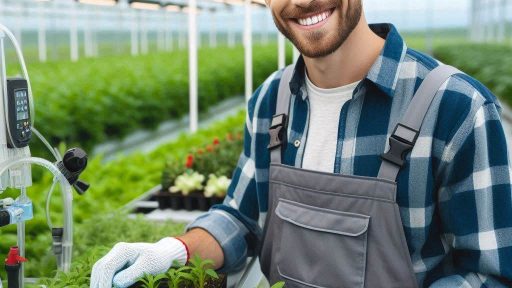Introduction
Flood proof farms innovative adaptation are crucial for ensuring food security and mitigating the devastating impact of floods.
In this blog post, we will delve into inspiring tales of farmers who have ingeniously adapted their farms to endure floods.
The challenges posed by flooding are immense, with crop damage, livestock loss, and infrastructure destruction.
Recognizing the need for resilience, these farmers serve as beacons of hope and innovation.
First, let’s hear the story of Sarah, a farmer from a flood-prone region.
Sarah implemented elevated beds, allowing water to pass through without submerging her crops.
She now harvests bountiful crops, regardless of heavy rainfall.
Next, we have David, who faced recurring floods in his low-lying farm.
Determined not to lose his livelihood, David constructed raised platforms for his livestock, ensuring their safety during floods.
His adaptability has saved countless animals.
Moving on, Linda serves as an inspiration with her implementation of water storage systems.
By collecting and conserving rainwater, she has created a reliable irrigation source during dry spells and accumulated excess water to mitigate flood damages.
Now, let’s journey to the flood-prone deltas of Southeast Asia, where Mai leads by example.
Mai successfully introduced floating gardens, where plants grow on buoyant platforms, adapting to the rising water levels during floods.
Lastly, there’s Mark, a farmer who embraced hydroponics to secure his crops.
By growing plants without soil in controlled environments, he eliminated the risk of soil erosion caused by flooding, guaranteeing a consistent harvest.
In short, flooding remains a prevalent threat to farms worldwide.
However, through ingenuity and determination, farmers like Sarah, David, Linda, Mai, and Mark show that flood-proofing is not only possible but also essential for sustainable agriculture.
Their stories empower us to replicate their innovative strategies and foster a resilient farming community.
Common Challenges Faced by Farmers during Floods
The detrimental effects of floods on farms
- Floods can destroy crops, wash away topsoil, and contaminate water sources.
- They can also damage farm infrastructure such as buildings, fences, and irrigation systems.
- Floodwaters can carry debris, pesticides, and chemicals, polluting the agricultural land.
- Floods disrupt farming activities, making it difficult for farmers to access their fields and tend to their livestock.
The vulnerability of agricultural infrastructure, crops, and livestock
- Agricultural infrastructure like barns and storage facilities can be damaged or completely destroyed.
- Crops can be submerged in water, resulting in reduced yields or total loss.
- Livestock can be stranded or drowned, leading to significant economic losses for farmers.
- Floods also increase the risk of disease outbreaks among livestock due to unsanitary conditions.
The financial losses and environmental impacts caused by floods
- Floods can lead to substantial financial losses for farmers, including crop damage and loss of income.
- Repairing or rebuilding damaged infrastructure can be costly and time-consuming.
- Due to erosion, floods can wash away valuable topsoil, degrading the fertility of the land.
- Contamination of water sources can harm aquatic ecosystems and pose risks to human health.
Read: Irrigation in Crisis: Climate Change and Water Use
John’s Floating Farm
Background: John’s farm is located in a region prone to frequent flooding.
Despite the challenges, John was determined to find a way to continue farming and adapt to the environmental conditions.
John’s innovative solution: In order to overcome the flooding problem, John came up with the idea of creating a floating farm.
He designed a unique system that allowed his farm to stay afloat during floods.
Features and benefits of John’s floating farm design
- Modular construction: John’s farm is built using modular components, making it easy to assemble and disassemble as needed.
- Floating platforms: The farm has multiple floating platforms that can adjust the height according to the water levels, ensuring that the crops are always above water.
- Greenhouse dome: John’s farm includes a greenhouse dome that protects the crops from extreme weather conditions and provides optimal growing conditions.
- Hydroponic system: John implemented a hydroponic system for cultivating crops, eliminating the need for soil and maximizing space utilization.
- Solar power: The floating farm is equipped with solar panels that generate clean energy for lighting and powering the farm’s operations.
- Water management: John’s design incorporates a sophisticated water management system, collecting and recycling rainwater to irrigate the crops.
Benefits of John’s floating farm
- Resilience: The floating farm can withstand flooding, ensuring that the crops remain undamaged.
- Sustainability: The use of solar power and water recycling minimizes the farm’s environmental impact.
- Optimal growing conditions: The greenhouse dome and hydroponic system create a controlled environment for improved crop yield.
- Adaptability: The farm’s modular construction allows for easy relocation in case of changing flood patterns.
Lessons for other farmers
- Think outside the box: John’s floating farm demonstrates the importance of innovation and thinking creatively to overcome challenges.
- Consider modular designs: Building farms using modular components can provide flexibility and adaptability in various environmental conditions.
- Utilize renewable energy: Incorporating solar power or other renewable energy sources can reduce reliance on traditional power grids and lower operating costs.
- Invest in water management systems: Implementing efficient water management systems can help optimize water usage and reduce water-related risks.
- Explore alternative cultivation methods: Hydroponics and other techniques can offer higher yields and resource efficiency compared to traditional farming methods.
John’s floating farm stands as a remarkable example of how innovative adaptation techniques can enable farmers to thrive in challenging environments.
By learning from John’s experience, other farmers can gain valuable insights and inspiration to develop their own resilient and sustainable farming practices.
Read: Preserving Soil Moisture Amidst Drought
Sarah’s Elevated Greenhouses
In the picturesque countryside, Sarah’s farm sits alongside a winding river, boasting fertile soil for her crops.
However, this idyllic setting comes with its own set of challenges.
Recurrent flooding wreaks havoc on Sarah’s livelihood, submerging her fields and damaging her crops and infrastructure.
Determined to find a solution, Sarah embarked on a journey of innovation.
She developed the concept of elevated greenhouses, a groundbreaking idea to shield her crops from floodwaters.
By raising the level of the greenhouses, Sarah ensured that her precious plants remained safe even during the most severe flood events.
Transform Your Agribusiness
Unlock your farm's potential with expert advice tailored to your needs. Get actionable steps that drive real results.
Get StartedThe advantages of utilizing elevated greenhouses in flood-prone areas are manifold
- Crop Protection: Elevated greenhouses serve as a protective barrier, shielding crops from floodwaters and minimizing damage.
- Year-round Cultivation: The controlled environment within the greenhouses allows for continuous cultivation, irrespective of external weather conditions.
- Higher Yields: With the ability to cultivate crops year-round, Sarah experiences higher yields compared to traditional farming methods.
- Minimized Weather Effects: The consistent conditions inside the greenhouses mitigate the impact of extreme weather events, such as storms, ensuring crop stability.
Sarah’s investment in elevated greenhouses has yielded exceptional outcomes for her farm
- Despite the challenges of recurrent flooding, Sarah has successfully maintained a consistent supply of fresh produce to her customers.
- The elevated greenhouses have become the cornerstone of her farming operation, safeguarding her crops and ensuring the sustainability of her business.
- Sarah’s innovative approach has garnered attention beyond her own farm. She has become a beacon of inspiration for other farmers facing similar challenges, offering guidance and support in implementing elevated greenhouse technology.
In general, Sarah’s story is a testament to the power of innovation and adaptation in overcoming environmental challenges.
Her elevated greenhouses not only provide practical solutions for flood-prone areas but also pave the way for sustainable farming practices in the future.
Through her resilience and creativity, Sarah has transformed adversity into opportunity, leaving a lasting impact on her community and the agricultural industry as a whole.
Read: Heatwaves and Hops: Brewing in a Hotter World

Mike’s Flood-Resistant Livestock Housing
Introducing Mike and His Farm
Meet Mike, a resilient farmer who has faced numerous problems during flood events on his farm.
Living in an area prone to flooding, he constantly worried about the safety and well-being of his livestock.
Mike’s Innovative Approach
Tired of experiencing losses due to flooding, Mike decided to take matters into his own hands.
He came up with an innovative approach to building flood-resistant livestock housing.
The Features and Benefits of Mike’s Flood-Resistant Structures
Mike’s flood-resistant structures are designed with several key features that set them apart:
- High elevation: Mike elevated his livestock housing to ensure they remain above flood levels.
- Sturdy construction: The structures are built using reinforced concrete and steel to withstand strong flood currents.
- Waterproofing: Mike implemented an advanced waterproofing system to keep the interiors dry and prevent any water damage.
- Ample ventilation: Proper airflow is maintained to prevent the build-up of moisture and mold.
The benefits of these structures are significant
- Protection for livestock: Mike’s flood-resistant housing ensures the safety and well-being of his animals during flood events.
- Minimal financial losses: By investing in flood-resistant structures, Mike has reduced the risk of losing valuable livestock.
- Peace of mind: Knowing that his animals are safe even in the face of a flood provides Mike with peace of mind.
Positive Impacts and Advantages of Mike’s Adaptation
Mike’s innovative adaptation has brought about positive impacts and advantages:
- Increased productivity: With a flood-resistant livestock housing in place, Mike’s farm has experienced consistent productivity even during flood events.
- Better animal health: The improved living conditions in the flood-resistant structures have resulted in healthier and happier livestock.
- Improved farm resilience: Mike’s adaptation has made his farm more resilient to future flood events, reducing the impact on his business.
- Recognition and influence: Mike’s innovative approach has gained recognition within the farming community, making him a source of inspiration for others facing similar challenges.
Mike’s flood-resistant livestock housing is a shining example of how farmers can adapt to the challenges posed by flooding.
By taking a proactive and innovative approach, Mike has not only protected his livestock but also enhanced the overall resilience and productivity of his farm.
Read: Climate Impact: Soil Salinity and Solutions
Key Takeaways for Farmers to Implement Flood-Proofing Strategies
The common strategies employed by the farmers in the case studies
- The farmers implemented effective drainage systems to prevent water accumulation.
- They constructed elevated platforms or raised beds to protect their crops from floodwaters.
- Building levees and flood barriers helped to divert or contain floodwaters.
- Creating water storage ponds or reservoirs helped manage excess water during floods.
- Implementing erosion control measures such as terracing or contouring helped prevent soil loss.
Tips for farmers to begin flood-proofing their own farms
- Assess your farm’s vulnerability to floods by studying historical flood data and consulting experts.
- Design an effective drainage system that can efficiently remove excess water from the fields.
- Consider constructing elevated platforms or raised beds to protect crops in flood-prone areas.
- Build levees, flood barriers, or embankments strategically to divert or contain floodwaters.
- Create water storage ponds or reservoirs to manage excess water during floods for later use.
- Implement erosion control measures like terracing or contouring to prevent soil erosion during floods.
- Develop a comprehensive emergency plan that includes evacuation routes and safe places for livestock.
- Invest in flood insurance to mitigate the financial risks associated with potential flood damage.
The importance of early planning and collaboration with experts
Early planning is crucial for implementing effective flood-proofing strategies:
- Consult experts, like agricultural engineers or hydrologists, to assess your farm’s flood vulnerability.
- Involve local authorities or agencies responsible for managing floodplain regulations and resources.
- Collaborate with neighboring farmers to share knowledge, resources, and collectively address flood risks.
Encourage farmers to learn from the experiences of others and adapt their techniques accordingly
Learning from others’ experiences can enhance flood-proofing efforts:
- Study case studies and success stories of farmers who have effectively implemented flood-proofing strategies.
- Attend local workshops, seminars, or conferences to gain insights from experts and experienced farmers.
- Join farmer networks or associations focused on sustainable farming practices and flood mitigation strategies.
- Regularly update your knowledge about innovative flood-proofing techniques through publications and online resources.
Implementing flood-proofing strategies is essential for protecting farms from the devastating effects of floods.
By summarizing the common strategies employed by farmers in case studies and providing actionable tips, farmers can begin implementing their own flood-proofing measures.
Early planning, collaboration with experts, and learning from the experiences of others are key factors in successful flood-proofing efforts.
By taking these steps, farmers can mitigate the risks posed by floods and ensure the resilience of their farms in the face of climate change and unpredictable weather patterns.
Discover More: Regenerative Agri: Earth’s Lifeline
Conclusion
Flood-proofing farms is crucial for sustainable agriculture.
By implementing innovative techniques, farmers can protect their crops and livelihoods from the devastating effects of floods.
It is essential to prioritize adaptation and seek professional guidance to implement effective flood-proof measures.
To further explore the topic, readers can delve into additional resources available on flood-proofing strategies and techniques.
By equipping themselves with knowledge and adopting innovative practices, farmers can secure a prosperous future for themselves and their communities.
Let us remember that challenges bring opportunities for growth and innovation.
Flood-proof farms not only ensure food security but also contribute to resilient and sustainable agricultural practices.
Farmers have the power to adapt and innovate in the face of adversity.
Therefore, let us encourage all farmers to embrace change and find inspiration in the success stories of flood-proofed farms.
By taking action today, we can create a future where agriculture thrives despite the risks posed by flooding.
Together, we can build a secure and prosperous future for all.




